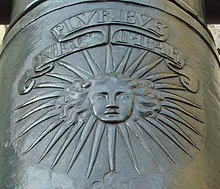
The Palace of Versailles is a former royal residence commissioned by King Louis XIV located in Versailles, about 19 kilometers (12 mi) west of Paris, France.
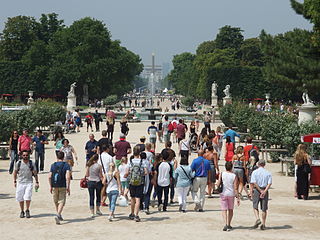
The Tuileries Garden is a public garden between the Louvre and the Place de la Concorde in the 1st arrondissement of Paris, France. Created by Catherine de' Medici as the garden of the Tuileries Palace in 1564, it was opened to the public in 1667 and became a public park after the French Revolution. Since the 19th century, it has been a place for Parisians to celebrate, meet, stroll and relax.
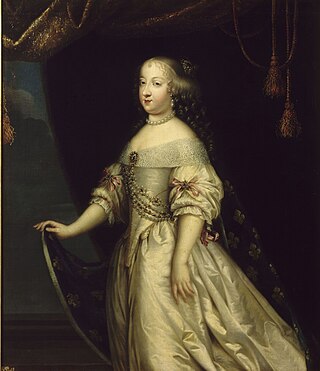
Maria Theresa of Spain was Queen of France from 1660 to 1683 as the wife of King Louis XIV. She was born an Infanta of Spain and Portugal as the daughter of King Philip IV and Elisabeth of France, and was also an Archduchess of Austria as a member of the Spanish branch of the House of Habsburg.

The Tuileries Palace was a royal and imperial palace in Paris which stood on the right bank of the Seine, directly in front of the Louvre. It was the Parisian residence of most French monarchs, from Henry IV to Napoleon III, until it was burned by the Paris Commune in 1871.
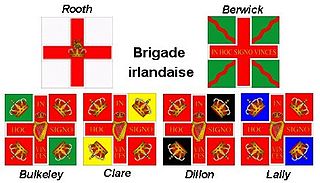
The Irish Brigade was a brigade in the French Royal Army composed of Irish exiles, led by Lord Mountcashel. It was formed in May 1690 when five Jacobite regiments were sent from Ireland to France in exchange for a larger force of French infantry who were sent to fight in the Williamite War in Ireland. The regiments comprising the Irish Brigade retained their special status as foreign units in the French Army until nationalised in 1791.

The Hall of Mirrors is a grand Baroque style gallery and one of the most emblematic rooms in the royal Palace of Versailles near Paris, France. The grandiose ensemble of the hall and its adjoining salons was intended to illustrate the power of the absolutist monarch Louis XIV. Located on the first floor of the palace's central body, it faces west towards the Palace Gardens. The Hall of Mirrors has been the scene of events of great historic significance, including the Proclamation of the German Empire and the signing of the Treaty of Versailles.

Marie Adélaïde of Savoy was the wife of Louis, Dauphin of France, Duke of Burgundy. She was the eldest daughter of Victor Amadeus II, Duke of Savoy, and of Anne Marie d'Orléans. Her betrothal to the Duke of Burgundy in June 1696 was part of the Treaty of Turin, signed on 29 August 1696. She was the mother of the future King Louis XV of France. Styled as Duchess of Burgundy after her marriage, she became Dauphine of France upon the death of her father-in-law, Le Grand Dauphin, in 1711. She died of measles in 1712, followed by her husband a week later.
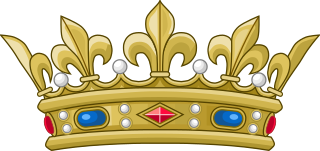
Fils de France was the style and rank held by the sons of the kings and dauphins of France. A daughter was known as a fille de France.
The phrase "the empire on which the sun never sets" has been used to describe certain global empires that were so territorially extensive that it seemed as though it was always daytime in at least one part of their territory.
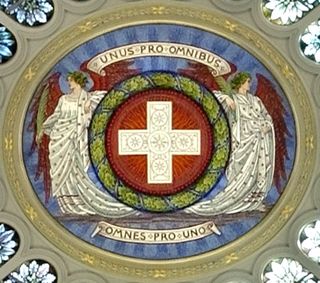
Unus pro omnibus, omnes pro uno is a Latin phrase that means One for all, all for one. It is the unofficial motto of Switzerland. This attitude is epitomized in the character of Arnold von Winkelried. A French version, Un pour tous, tous pour un, was made famous by Alexandre Dumas in the 1844 novel The Three Musketeers.

The Gardes du Corps du Roi was the senior formation of the King of France's household cavalry within the maison militaire du roi de France.

Jean-Florent de Vallière was a French artillery officer of the 18th century. He was lieutenant-general of the King's Armies. In 1726, de Vallière became Director-General of the Battalions and Schools of the Artillery.

The Canon de 24 de Vallière was a type of cannon designed by the French officer Florent-Jean de Vallière (1667–1759), Director-General of the Battalions and Schools of the Artillery.
The Canon de 4 de Vallière was a type of cannon designed by the French officer Florent-Jean de Vallière (1667-1759), Director-General of the Battalions and Schools of the Artillery.
The Canon de 12 de Vallière was a type of cannon designed by French officer Florent-Jean de Vallière (1667–1759), Director-General of the Battalions and Schools of the Artillery.

The Place du Carrousel is a public square in the 1st arrondissement of Paris, located at the open end of the courtyard of the Louvre Palace, a space occupied, prior to 1883, by the Tuileries Palace. Sitting directly between the museum and the Tuileries Garden, the Place du Carrousel delineates the eastern end of the gardens just as the Place de la Concorde defines its western end.
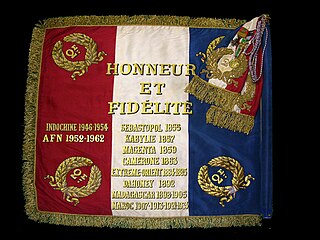
Honneur et Fidélité is the motto of the Foreign Legion in the French Armed Forces. It has been inscribed on Legion flags instead of the Honneur et Patrie inscribed on flags of the regular French Army of the French Republic. Nevertheless, both mottos share a similar past.

François Le Vau was a French architect and a founding member of the Académie Royale d'Architecture. He is also known for being the youngest brother of the more famous French architect, Louis Le Vau.

The Louis XIV style or Louis Quatorze, also called French classicism, was the style of architecture and decorative arts intended to glorify King Louis XIV and his reign. It featured majesty, harmony and regularity. It became the official style during the reign of Louis XIV (1643–1715), imposed upon artists by the newly established Académie royale de peinture et de sculpture and the Académie royale d'architecture. It had an important influence upon the architecture of other European monarchs, from Frederick the Great of Prussia to Peter the Great of Russia. Major architects of the period included François Mansart, Jules Hardouin Mansart, Robert de Cotte, Pierre Le Muet, Claude Perrault, and Louis Le Vau. Major monuments included the Palace of Versailles, the Grand Trianon at Versailles, and the Church of Les Invalides (1675–1691).
François Huguet was a 17h–18th-century French architect. He died around 1730.
